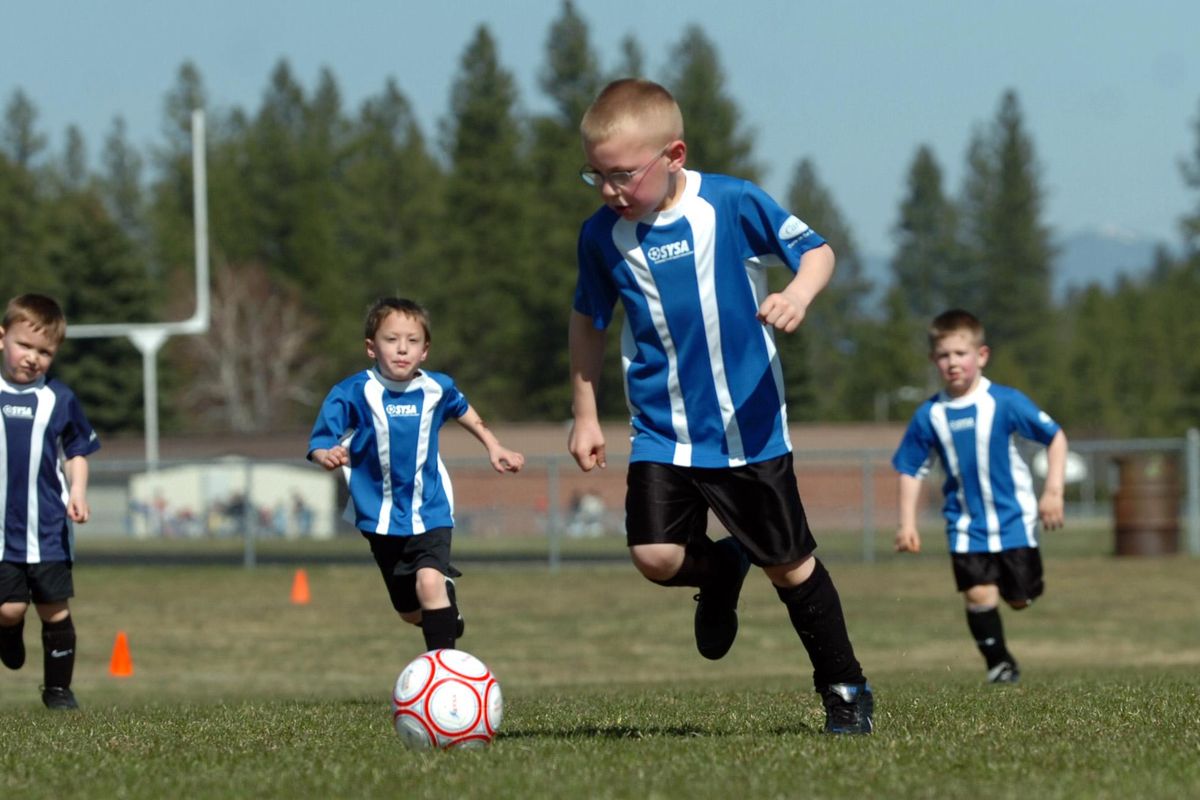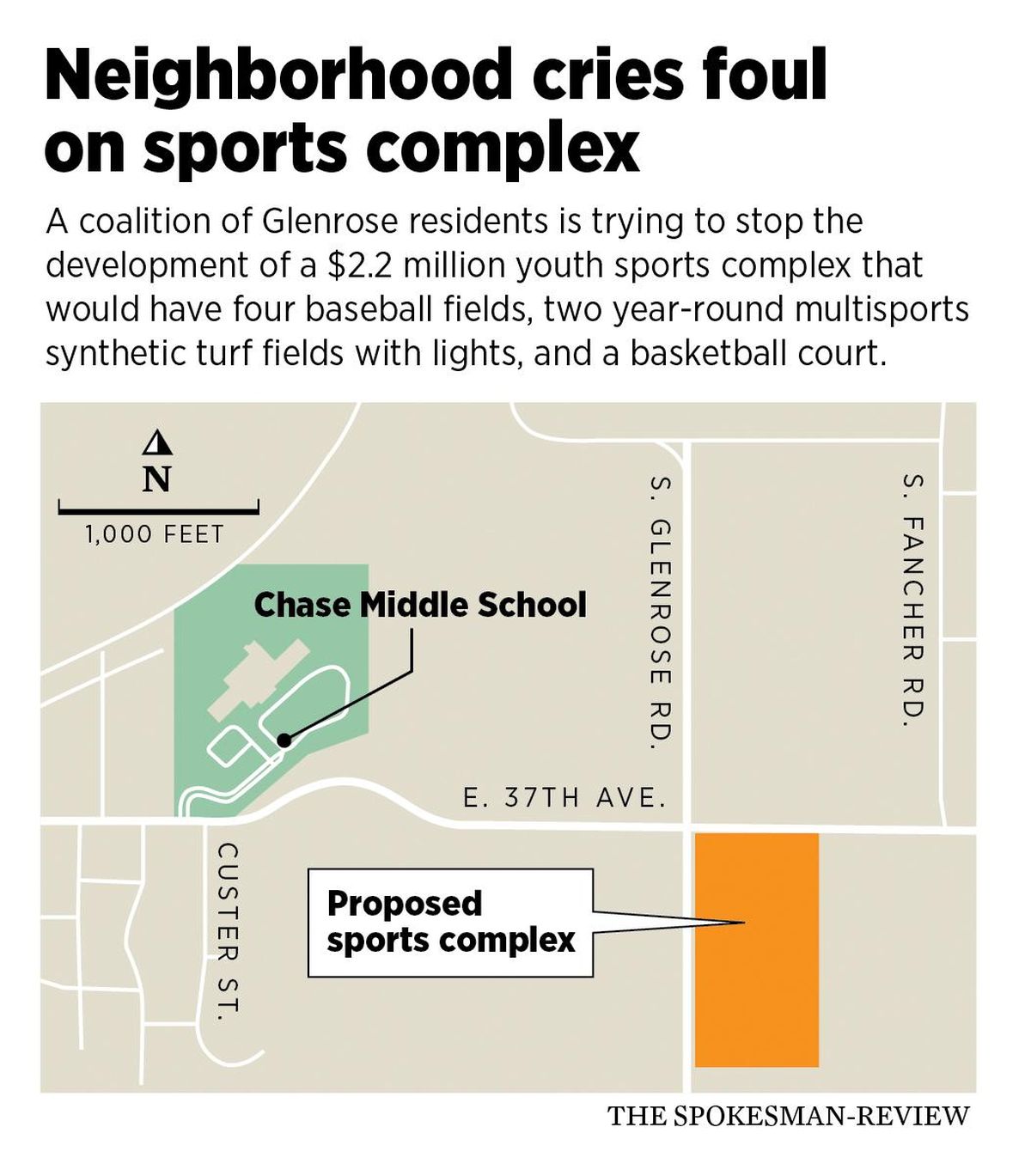Proposed youth sports complex in Glenrose area draws neighborhood ire
C.J. Niska, 5, dribbles the ball in a Spokane Youth Sports Association game at Farwell Rd. field complex Saturday, April 12, 2008. (Jesse Tinsley / The Spokesman-Review)Buy a print of this photo
A coalition of Glenrose residents has threatened legal action to stop the development of a $2.2 million youth sports complex on 20 acres of rural land southeast of Spokane they say will “forever alter the Glenrose neighborhood.”
The Glenrose Association sent a letter last week to the Spokane Youth Sports Association citing numerous permitting and legal hurdles for the project and urged the SYSA to “address the serious concerns of the neighborhood.”
“You can avoid the expense, delay and uncertainty of permit and legal battles and retain control of the outcomes,” states the letter, written by local lawyer Rick Eichstaedt for the Seattle-based environmental law firm Bricklin & Newman. “You have little to lose and much to gain by seeking a mutually acceptable solution with your would-be neighbors.”
The development, the letter argues, would create traffic congestion and require extensive lighting, harming the neighborhood’s residents and character.
A day later, Philip Helean, SYSA’s executive director, responded to the three-page letter with a one-sentence reply, saying the group’s members “respectfully disagree with its content.”
Helean said Tuesday he had no comment about the proposed development or the Glenrose letter, and would not confirm he wrote the response.
“We don’t have any comments,” he said. “No comments.”
John Pederson, Spokane County’s planning director, did not know of the letter from the Glenrose group, but said the county’s processes would mitigate any issues arising from the development. He noted that the county’s hearing examiner reviewed a similar proposal on the same property in 2009, and much of what was determined then stands today.
“All the issues that are raised by the Glenrose Association were addressed by the hearing examiner,” he said. “Nothing’s changed. We have no pending permits. Nothing has happened since the last environmental process 10 years ago.”
Pederson declined to go into details on the issues facing the neighborhood, property and development, saying the “file is very extensive. Not something I can describe in a couple of sentences. The file is a foot thick.”
SYSA did have a pre-development meeting with the county in 2017, when it submitted site plans. Pederson said the examiner’s decade-old environmental review has concrete solutions to deal with issues of traffic and excessive nighttime lighting of the facility.
“There’s a whole slew of mitigation measures that were applied to this project,” he said.
Changing hands, same plan
The situation began a decade ago when the Spokane South Little League sought to develop a $4.5 million, 20-acre baseball complex on the southeast corner of 37th Avenue and Glenrose Road on land owned by Morning Star Boys’ Ranch. At the time, the Glenrose Association said the development would significantly increase noise, traffic and stormwater runoff. When the county issued a grading permit in October 2009, the neighborhood association appealed, leading to a decision by Mike Dempsey, the hearing examiner.
Dempsey’s ruling said a traffic impact analysis had to be done before a building permit could be issued, and said the league had to comply with all noise and disturbance standards set out by the county.
During this time, the Morning Star Boys’ Ranch transferred the property to the Morning Star Foundation. With no sign of development in 2012, the foundation sold the 20 acres to South Spokane Little League for $577,000. Four years later, development had yet to begin and the property was sold to SYSA in 2016 for $476,000.
Under SYSA – which runs youth sports leagues for soccer, flag football, track, cross country, rugby, basketball, baseball and softball – the plan now is to build a multiuse sports complex.
A grant application filed by SYSA with the state Recreation and Conservation Funding Board says the $2.2 million development is called the Zakheim Youth Sports Complex. According to the application, the sports complex will “build one multipurpose sports field, a parking lot, storage facilities, and restrooms. When fully developed, the sports complex will include four youth baseball fields, two multi-sports fields with lights, a basketball court, storage facilities, restrooms, and a walking path. The multi-use field could be used year-round and will be the only synthetic turf field on the South Hill.”
The neighborhood association, however, said the development was proceeding on an “erroneous” characterization by the Spokane County Building and Planning Department, which defines the project as a “community recreation facility.” Under this designation, the complex is intended for “amusement, relaxation, or diversion from normal activities for persons within the area which it is located.”
As a “regional sports hub,” the neighborhood association argues the correct definition is “participant sports and recreation” facility, a use not allowed in the zoning on SYSA’s property.
Pederson, the county’s planning director, said the “community recreation facility” is the right definition, because it says the use is “not operated for profit.”
“It’s a nonprofit situation,” he said. “That’s the definition.”
Eichstaedt, the association’s lawyer, disagreed, saying the county only defined the project’s land that way “so it can move forward.”
“I think it’s that definition so it fits the zoning out there,” he said. “We did exhaustive public records requests looking for uses under ‘community recreation facility.’ There’s nothing out there that would support the definition he gave you.”
The neighborhood association’s letter also said the complex would require the construction of new roads, a large parking lot and “extensive lighting” for night games, to the detriment of the neighborhood.
According to Spokane County, 37th carries about 2,000 cars a day in this area, and Glenrose carries between 3,800 and 5,200 vehicles a day. The complex would cause a “large influx of vehicles” to come to the neighborhood “in the short windows of time before and after games that will cause significant traffic impacts,” the association’s letter said.
Glenrose grows
The increase in traffic is what most concerns Bob Hyslop, the association’s president, who has lived in Glenrose for 33 years.
“What I’ve seen is the city is continuing to work its way out as time goes along,” he said. “One thing that’s changed quite a bit in more recent times, with all the development off of Regal – the apartment complexes and whatnot – the pressure on Freya and Thor has increased so there’s a lot of people coming down Glenrose. There are only so many ways you can get off the South Hill.”
Hyslop said the only real solution to preventing worse traffic caused by the development is to stop the development altogether. That’s his goal, and he says it’s the sentiment of his neighbors.
“I’ve polled the community pretty intensely over the past couple of years,” he said. “Close to 100% of the people are against it. It’s significant. It’s very significant. So then you have to ask why. The biggest concern people have is the traffic impact. The second biggest impact, and probably the most invasive thing about the deal, is their plan to put in stadium lighting.”
Eichstaedt, who said he sees an outcome that allows the project to proceed, faults SYSA for its unwillingness to talk with the Glenrose Association. He noted that the association tried to initiate meetings three times with SYSA – in October 2017, November 2017 and February 2018 – but were denied.
“Nobody wants to end up in a prolonged legal battle. The neighbors have tried three times to sit down with SYSA and work through this,” he said. “We’ll hold our nose and allow this to move forward, but there needs to be a solution to these problems.”
First, though, Eichstaedt has tried to throw a wrench in SYSA’s application to the state’s recreation funding board, where it’s seeking a $350,000 grant for the project. The application said the project had a valid grading permit, which it doesn’t, according to both Eichstaedt and Pederson. The letter to the state body was sent last week as well.
“No neighborhood wants to fight with youth sports. This isn’t fighting a bad developer,” Eichstaedt said. “But everybody has to follow the rules and everybody has to be a good neighbor.”

